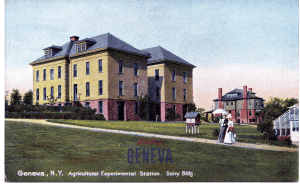Cornell Agritech
Every site tells a story. Once part of an 18th century Haudenosaunee settlement and a 19th century farm, Cornell Agritech has become a center for food and agriculture research, innovation, and development. Below are some highlights from its history.
- The land it now sits on was once part of a Native American settlement. In the 1700s the Seneca (Onödowá’ga) had several towns near Geneva. One of them, Kanadesaga served as a major Seneca capital between 1754 and 1779. The town was in the area where Pre-emption and County 4 Roads meet. In 1779 the Sullivan-Clinton Campaign destroyed Kanadesaga and other Haudenosaunee villages and burned acres of fields and orchards.
- Eventually what had been Kanandesaga and the surrounding area was divided into farms. One of the farms became known as Castle Farm.
- In September 1852 newlyweds Nehemiah and Louise Denton purchased Castle Farm. Little, however, is known about the Denton family. Nehemiah Denton was a born deaf in Brooklynn and was orphaned by the age of two. In July 1852, after turning 21, Nehimiah inherited a small fortune from his grandfather and married Louise Moore. Like Nehimiah, Louise was deaf, but her deafness was caused by an illness. It is unclear why the couple chose to settle in Geneva. The Dentons raised two daughters (Louise and Helena) on the farm.
- When the Dentons purchased the farm there was already a Federal style structure on site. That structure was incorporated into their Italianate House (now Parrott Hall). Along with the house, the property included a carriage house, tool house, ice house, barns and 20 acres of fruit.
- By 1882, Nehemiah was declared as having an unsound mind. To settle his debts, the house, outbuildings, and 130 acres were sold to New Yore State. Louisa died in 1886 and Nehemiah nine years later.
- Cornell Agritech was established in 1880 (then known as the New York Agricultural Experiment Station) to “promote agriculture in various branches of scientific investigation and experimentation.” For the first nine years, apart from barns, the sole building was Denton House (now Parrott Hall). In addition to holding offices and labs, it was the residence for the Director. Early research focused on vegetable and field crops; dairy cows, beef cattle, poultry and swine; and identifying and combating insect and plant diseases.
- Over time more buildings were added, including the Chemical Lab in 1891, Dairy and Biological Building in 1897, and a residence for the Director in 1900.
- In 1923 Agritech became part of Cornell University’s College of Agriculture and Life Science.
- By 1941 researchers were granted the title of professor.
- Although all animal research was transferred to Cornell’s Ithaca Campus, departments of chemistry, insects, food science, plant diseases, seed testing, and vegetable production were added by the end of the 1940s.
- Though the nature of investigating has changed over the years, researchers still address the same issues safeguarding the production of fruits and vegetables, developing new crops, enhancing food safety, and promoting economically viable farming solutions.
- What began with one house and a few outbuildings on 130 acres of land has grown to over 20 major buildings, 900 acres of orchards and fields and over 300 faculty, staff, and students.
On October 29 join Historic Geneva for an evening at Jordan Hall. Listen to a talk by Historic Geneva Curator John Marks on the history of the site. Get an update on the status of Parrott Hall. Hear about Agritech’s current activities from Chris Smart, Goichman Family Director of Cornell Agritech. The event will run from 7 to 9 pm. Desserts will be served. The event is open to the public. Suggested donation of $25 a person with proceeds benefiting Historic Geneva.


Well done, John
I hope the event will be well attended.
Pim